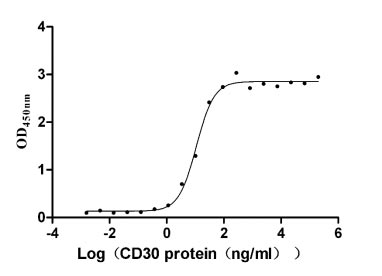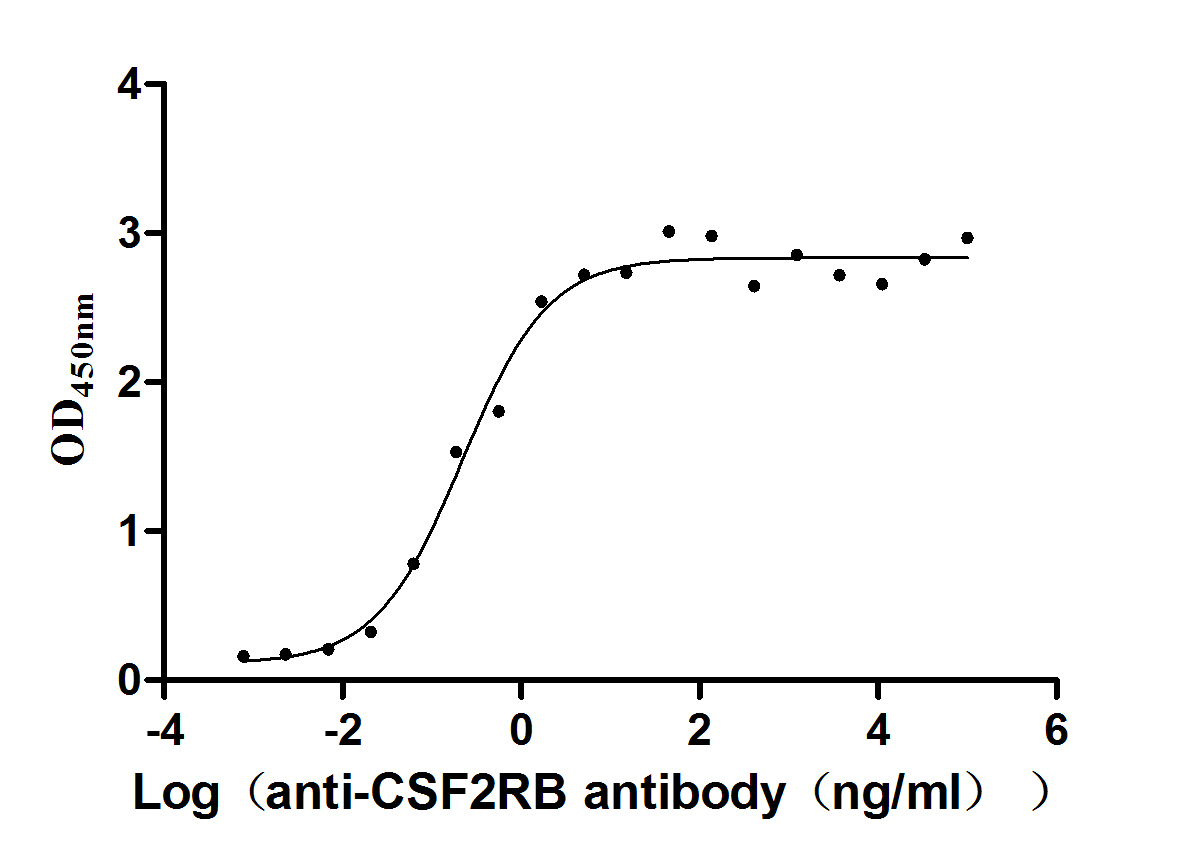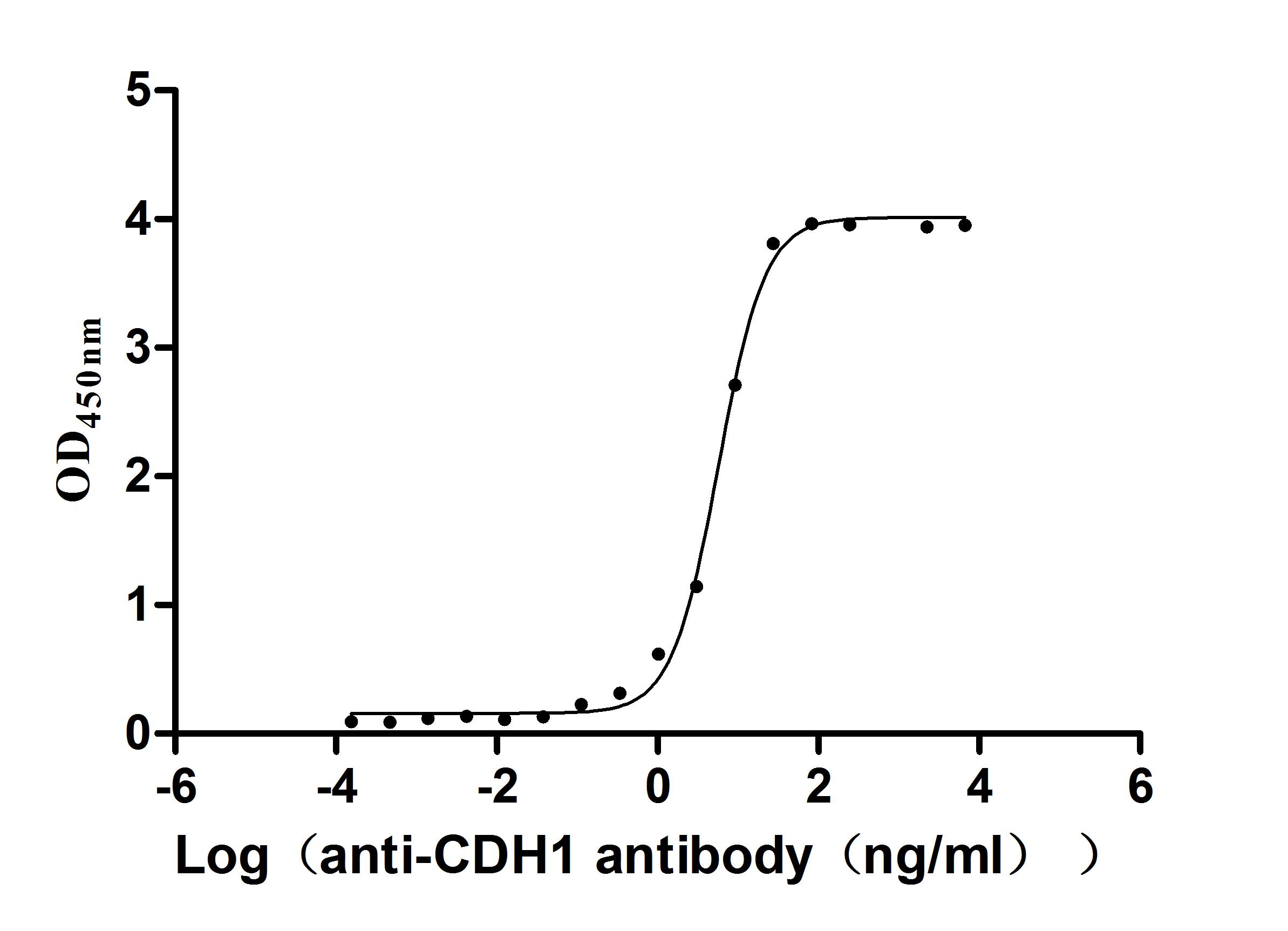Recombinant Mouse Phospholipid transfer protein (Pltp)
-
货号:CSB-YP018212MO
-
规格:
-
来源:Yeast
-
其他:
-
货号:CSB-EP018212MO-B
-
规格:
-
来源:E.coli
-
共轭:Avi-tag Biotinylated
E. coli biotin ligase (BirA) is highly specific in covalently attaching biotin to the 15 amino acid AviTag peptide. This recombinant protein was biotinylated in vivo by AviTag-BirA technology, which method is BriA catalyzes amide linkage between the biotin and the specific lysine of the AviTag.
-
其他:
-
货号:CSB-BP018212MO
-
规格:
-
来源:Baculovirus
-
其他:
-
货号:CSB-MP018212MO
-
规格:
-
来源:Mammalian cell
-
其他:
产品详情
-
纯度:>85% (SDS-PAGE)
-
基因名:
-
Uniprot No.:
-
别名:Pltp; Phospholipid transfer protein; Lipid transfer protein II
-
种属:Mus musculus (Mouse)
-
蛋白长度:Full Length of Mature Protein
-
表达区域:18-493
-
氨基酸序列ELP GCKIRVTSAA LDLVKQEGLR FLEQELETIT IPDVYGAKGH FYYNISDVRV TQLHLISSEL HFQPDQDLLL NISNASLGLH FRRQLLYWFL YDGGYINASA EGVSIRTGLQ LSQDSSGRIK VSNVSCEASV SKMNMAFGGT FRRMYNFFST FITSGMRFLL NQQICPVLYH AGTVLLNSLL DTVPVRSSVD DLVGIDYSLL KDPVVSNGNL DMEFRGAFFP LKEDNWSLPN RAVEPQLEDD ERMVYVAFSE FFFDSAMESY FQAGALQLTL VGDKVPSDLD MLLRATYFGS IVLLSPTVIN SPLKLKLEAT SPPRCTIKPS GTTISITASV TITLAPPMLP EVELSKMIME GRLSAKLTLR GKALRVKLDL RRFQIYSNQS ALESLALIPL QAPLKTLLQI GVMPLLNERT WRGVQIPLPE GINFVREVVT NHAGFVTVGA DLHFAKGLRE VIDKNRPADV AASHVPPPSA AAA
-
蛋白标签:Tag type will be determined during the manufacturing process.
The tag type will be determined during production process. If you have specified tag type, please tell us and we will develop the specified tag preferentially. -
产品提供形式:Lyophilized powder
Note: We will preferentially ship the format that we have in stock, however, if you have any special requirement for the format, please remark your requirement when placing the order, we will prepare according to your demand. -
复溶:We recommend that this vial be briefly centrifuged prior to opening to bring the contents to the bottom. Please reconstitute protein in deionized sterile water to a concentration of 0.1-1.0 mg/mL.We recommend to add 5-50% of glycerol (final concentration) and aliquot for long-term storage at -20℃/-80℃. Our default final concentration of glycerol is 50%. Customers could use it as reference.
-
储存条件:Store at -20°C/-80°C upon receipt, aliquoting is necessary for mutiple use. Avoid repeated freeze-thaw cycles.
-
保质期:The shelf life is related to many factors, storage state, buffer ingredients, storage temperature and the stability of the protein itself.
Generally, the shelf life of liquid form is 6 months at -20°C/-80°C. The shelf life of lyophilized form is 12 months at -20°C/-80°C. -
货期:Delivery time may differ from different purchasing way or location, please kindly consult your local distributors for specific delivery time.Note: All of our proteins are default shipped with normal blue ice packs, if you request to ship with dry ice, please communicate with us in advance and extra fees will be charged.
-
注意事项:Repeated freezing and thawing is not recommended. Store working aliquots at 4°C for up to one week.
-
Datasheet :Please contact us to get it.
相关产品
靶点详情
-
功能:Mediates the transfer of phospholipids and free cholesterol from triglyceride-rich lipoproteins (low density lipoproteins or LDL and very low density lipoproteins or VLDL) into high-density lipoproteins (HDL) as well as the exchange of phospholipids between triglyceride-rich lipoproteins themselves. Facilitates the transfer of a spectrum of different lipid molecules, including sphingomyelin, phosphatidylcholine, phosphatidylinositol, phosphatidylglycerol, and phosphatidyl ethanolamine. Plays an important role in HDL remodeling which involves modulating the size and composition of HDL. Also plays a key role in the uptake of cholesterol from peripheral cells and tissues that is subsequently transported to the liver for degradation and excretion. Two distinct forms of PLTP exist in plasma: an active form that can transfer phosphatidylcholine from phospholipid vesicles to HDL, and an inactive form that lacks this capability.
-
基因功能参考文献:
- this work reports a physiological role for PLTP in the polarization of CD4(+) T cells toward the pro-inflammatory Th1 phenotype. PMID: 26320740
- these findings elucidated that PLTP repressed LPS induced inflammation due to extracellular LPS binding capability, and the protective effects were not related to HDL pool size in mice. PMID: 26857615
- Data presented a novel model to link phospholipid metabolism to APP processing and also suggested that PLTP played an important role in Abeta metabolism and would be useful to further elucidate functions of PLTP in Alzheimer's disease susceptibility. PMID: 26160914
- In hepatocytes, initial recruitment of phospholipid (PL) by apoB:1000 leading to the formation of the PL-rich apoB-containing initiation complex is mediated to a large extent by PLTP. PMID: 25638820
- PLTP plays an important role in modulating the stability of atherosclerotic plaques. The receptor-interacting protein 3- reactive oxygen species signal pathway could be involved in this PLTP-mediated process. PMID: 25324570
- Adipocyte PLTP plays a small but significant role in plasma PLTP activity and promotes cholesterol efflux from adipose tissues. PMID: 25477345
- PLTP exerts significant effects on apoA-I lipidation and nascent HDL biogenesis in hepatocytes by promoting ATP-binding cassette transporter A1-mediated lipid efflux and the remodeling of nascent HDL particles. PMID: 25060793
- Plasma Sphingosine-1-phosphate contents were decreased by 60.1 % in PLTP knockout mice (PLTP-/-, N = 5) compared with their wild type littermates (WT, N = 5) (151.70 +/- 38.59 vs. 379.32 +/- 59.90 nmol/l, P<0.01). PMID: 24158769
- Therefore we concluded that PLTP deficiency impaired cognition and aggravated AD by enhancing the generation of Abeta in the cortex of old mice. PMID: 24121956
- Cerebrovascular oxidative stress increased in PLTP deficient mice, including increased levels of reactive oxygen species (ROS) and lipid peroxidation marker 4-hydroxy-2-nonenal (HNE) and reduced superoxide dismutase (SOD) activity. PMID: 24513285
- PLTP is actively involved in lipid transfer, cholesterol efflux, HDL genesis, and remodeling at the blood-brain barrier. PMID: 24369175
- PLTP can play a significant role in the pathophysiology of abdominal aortic aneurysm. PMID: 23830874
- Liver-specific PLTP deficiency significantly reduces plasma HDL and apoB-containing lipoprotein levels. PMID: 23846500
- The results of this study suggested that PLTP, through its ability to deliver vitamin E to the brain, constitutes an endogenous neuroprotective agent. Increasing PLTP activity may offer a new way to develop neuroprotective therapies. PMID: 23303044
- Our results suggest, for the first time, that the major function of liver PLTP is to drive VLDL production and makes a small contribution to plasma PLTP activity. PMID: 22367708
- presence of PLTP in tear fluid appears to be essential for maintaining a healthy and functional ocular surface PMID: 21514421
- the SR-BI pathway contributes in unique ways to cholesterol metabolism and atherosclerosis susceptibility even in the presence of CETP PMID: 21454568
- Diet-induced lipid accumulation in phospholipid transfer protein-deficient mice: its atherogenicity and potential mechanism PMID: 20543142
- PLTP increases blood coagulation and worsens the extent of ischemic lesions in response to acute oxidative stress. PMID: 20864671
- It is concluded that PLTP is essential in mediating the association of triacyl lipid A with lipoproteins, leading to extension of its residence time and to magnification of its proinflammatory and anticancer properties. PMID: 20418497
- increased PLTP permits triglyceride incorporation into abnormally large VLDL, which are removed from plasma by LDL receptors PMID: 20037162
- data show that PLTP regulates the bioavailability of vitamin E in atherogenic lipoproteins and suggest a novel strategy for achieving more effective concentrations of anti-oxidants in lipoproteins, independent of dietary supplementation PMID: 12105225
- pltp is regulated by liver X receptors in mice PMID: 12177004
- elevated PLTP activity in human cholesteryl ester transfer protein (huCEPT) transgenic mice results in an increase in VLDL secretion PMID: 12401886
- The phospholipid transfer protein gene is a liver X receptor target expressed by macrophages in atherosclerotic lesions. PMID: 12612088
- Two-fold increased plasma PLTP activity in apoE knockout mice results in a decrease in HDL cholesterol, HDL phospholipid, and apoAI levels and indicates that elevated plasma PLTP levels constitute a novel, long-term risk factor for atherosclerosis. PMID: 12855484
- PLTP has a role in transporting cholesterol and phospholipids from cells to lipoprotein particles by a process involving PLTP interactions with cellular ATP-binding cassette transporter A1 PMID: 14559902
- Five significant loci were identified as being involved in PLTP activity in the mouse and supporting evidence was provided for the candidacy of Nr1h4 and Apof as the genes underlying Pltpq2. PMID: 14592843
- LDL from PLTP0 mice was markedly resistant to oxidation and induced significantly less monocyte chemotactic activity compared with that in controls. In vitro, PLTP0 HDL removed significantly more oxidized phospholipids from LDL than did control HDL PMID: 15258196
- PLTP deficiency decreases liver vitamin E content, increases hepatic oxidant tone, and substantially enhances reactive oxygen species-dependent destruction of newly synthesized apolipoprotein B via a post-endoplasmic reticulum process. PMID: 15734742
- data suggested that PLTP may play important role(s) during in vivo preimplantation embryo development PMID: 15832314
- The effect of PLTP gene deletion on the fertility of male and female mice is reported. PMID: 16467369
- complex regulatory role of PLTP in serum and liver lipid homeostasis, as well as in the formation of nascent apoA-I-PL complexes from the liver PMID: 16554055
- Absence of endogenous phospholipid transfer protein impairs ABCA1-dependent efflux of cholesterol from macrophage foam cells. PMID: 16687660
- Macrophage PLTP deficiency causes a significant reduction of apoE secretion from the cells, and this in turn promotes the accumulation of cholesterol in the circulation and accelerates the development of atherosclerosis. PMID: 17038631
- PLTP deficiency in knockout mice results in reduced cholesterol uptake as well as secretion by the intestine. PMID: 17641249
- antiatherogenic properties of macrophage-derived PLTP are related at least in part to its ability to reduce cholesterol accumulation in macrophages through changes in the alpha-tocopherol content and oxidative status of the cells PMID: 17717294
- unlike total systemic PLTP, locally produced macrophage-derived PLTP beneficially alters lipoprotein metabolism and reduces lesion progression in hyperlipidemic mice PMID: 17928634
- PLTP appears to play a proatherogenic role in diet-induced hyperlipidemic mice PMID: 18198166
- PLTP expression by bone marrow derived cells results in atherogenic effects on plasma lipids, increased PLTP activity, high local PLTP protein levels in the atherosclerotic lesions and increased atherosclerotic lesion size PMID: 18509527
- PLTP transfer activity is essential for the development of atherosclerosis in PLTP transgenic mice. PMID: 18711210
- These findings indicate that plasma HDL level is an important regulator of plasma PLTP and might play a role in the stabilization of PLTP in plasma. PMID: 19422933
- Elevated PLTP activity lowers plasma HDL-cholesterol by stimulating the plasma turnover and hepatic uptake of HDL cholesteryl esters. PMID: 19524061
显示更多
收起更多
-
亚细胞定位:Secreted. Nucleus.
-
蛋白家族:BPI/LBP/Plunc superfamily, BPI/LBP family
-
组织特异性:Highest level expression in the lung, brain and heart with relatively low levels in the liver, skeletal muscle and testis and very low levels found in the spleen and kidney.
-
数据库链接:
KEGG: mmu:18830
STRING: 10090.ENSMUSP00000061519
UniGene: Mm.6105
Most popular with customers
-
Recombinant Human Tumor necrosis factor ligand superfamily member 8 (TNFSF8), partial (Active)
Express system: Mammalian cell
Species: Homo sapiens (Human)
-
Recombinant Human Cytokine receptor common subunit beta (CSF2RB), partial (Active)
Express system: Mammalian cell
Species: Homo sapiens (Human)
-
Recombinant Human E3 ubiquitin-protein ligase ZNRF3 (ZNRF3), partial (Active)
Express system: Mammalian cell
Species: Homo sapiens (Human)
-
Recombinant Human Transferrin receptor protein 1 (TFRC), partial (Active)
Express system: Mammalian cell
Species: Homo sapiens (Human)
-
Recombinant Human Interleukin-2 receptor subunit alpha (IL2RA), partial (Active)
Express system: Mammalian cell
Species: Homo sapiens (Human)
-
Recombinant Human CD81 antigen (CD81), partial (Active)
Express system: Mammalian cell
Species: Homo sapiens (Human)
-
Recombinant Human Myosin regulatory light chain 12B(MYL12B) (Active)
Express system: E.coli
Species: Homo sapiens (Human)
-
Recombinant Human Cadherin-1(CDH1),partial (Active)
Express system: Mammalian cell
Species: Homo sapiens (Human)




















